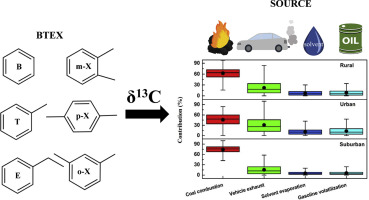当前位置:
X-MOL 学术
›
Atmos. Environ.
›
论文详情
Our official English website, www.x-mol.net, welcomes your
feedback! (Note: you will need to create a separate account there.)
Source apportionment of atmospheric volatile aromatic compounds (BTEX) by stable carbon isotope analysis: A case study during heating period in Taiyuan, northern China
Atmospheric Environment ( IF 4.2 ) Pub Date : 2020-03-01 , DOI: 10.1016/j.atmosenv.2020.117369 Yinghui Li , Yulong Yan , Dongmei Hu , Zhisheng Li , Aisheng Hao , Rumei Li , Cheng Wang , Yang Xu , Jingyuan Cao , Zhuocheng Liu , Lin Peng
Atmospheric Environment ( IF 4.2 ) Pub Date : 2020-03-01 , DOI: 10.1016/j.atmosenv.2020.117369 Yinghui Li , Yulong Yan , Dongmei Hu , Zhisheng Li , Aisheng Hao , Rumei Li , Cheng Wang , Yang Xu , Jingyuan Cao , Zhuocheng Liu , Lin Peng

|
Abstract Due to the high negative effects on health and environment, volatile aromatic compounds (benzene, toluene, ethylbenzene and xylene, BTEX) have drawn more and more attention recently. BTEX samples of four emission sources (coal combustion, vehicle exhaust, gasoline volatilization and solvent evaporation) and ambient air from three sampling sites (rural, urban and suburban) were collected during winter in Taiyuan, northern China. Gas chromatography–mass spectrometry and thermal desorption–gas chromatography–isotope ratio mass spectrometry were employed to investigate the composition characteristics and stable carbon isotopic (δ13C) analysis of BTEX, respectively. The results revealed that the δ13C value of BTEX for coal combustion, with the range of −23.8‰ to −25.2‰, was higher than that for vehicle exhaust, gasoline volatilization and solvent evaporation, ranging from −25.5‰ to −27.6‰, −28.0‰ to −30.9‰ and −27.7‰ to −32.1‰, respectively. Atmospheric BTEX concentrations were the highest at the suburban site (41.5 μg/m3) and the lowest at the rural site (27.0 μg/m3). The δ13C values of atmospheric BTEX at rural, urban and suburban sites ranged from −24.8‰ to −26.2‰ (average −25.3‰), −24.8‰ to −26.9‰ (average −26.0‰) and −23.9‰ to −25.4‰ (average −24.8‰), respectively, indicating that the suburban site was enriched in 13C relative to rural and urban sites. The B/T ratio results indicated that coal combustion was the primary source of atmospheric pollution in Taiyuan. The mean contribution of emission sources in all three sampling site were determined by adopting Isosource-based quantitative calculation. For rural, urban and suburban sites, coal combustion, as the major source, made mean contributions of 62.3%, 46.0% and 74.1%, while vehicle exhaust was responsible for 22.0%, 30.6% and 15.3%, respectively. Coal combustion and vehicle exhaust were the top two primary sources of BTEX in Taiyuan, especially coal combustion provided a half contribution to atmospheric BTEX. Therefore, implementing controls on coal combustion is crucial to reduce ambient volatile aromatic compound pollution, especially in areas with high coal consumption.
更新日期:2020-03-01











































 京公网安备 11010802027423号
京公网安备 11010802027423号